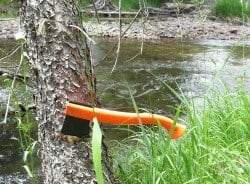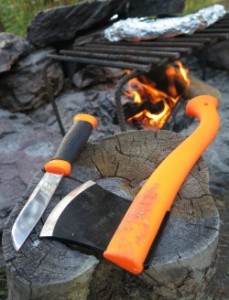Mora knives are the paracord of survival blades. Their utility is unquestioned, but not so much is their reliability as a true survival instrument. Having a partial tang, thin blade, plastic sheath, and average steel, the Mora Knife is more of an inexpensive convenience, but by no means the last word in survival blades. However, the Mora Knife is just the beginning of the Morakniv tool offerings to those with a survival bend. Among other things, Morakniv carries axes. One particular axe caught my eye for review, the compact Mora Camp Axe.
SKIP AHEAD
Mora Camp Axe Review
The Morakniv company began its journey in Mora, Sweden in 1891, with knives being little more than a product diversification to their lineup of timber sleds. That’s almost a century-long head start in front of Fallkniven, another well known Swedish blade maker. After 125 years of changing names and products, the formal company of Morakniv was born on January 1, 2016. No more timber sleds, no more ice drills, just knives, hatchets, and a few other things.
Small Bites
Speaking of Mora Hatchets, I thought it a good time to take one for a SurvivalCache spin. The Mora Camp Axe has much of the flavor of the famous Mora Knife with a plastic handle, thin blade, and utilitarian steel. One of the packaging options is a combination box that includes both the axe and a matching Mora knife.
| AXE | DETAILS | ||
|---|---|---|---|

Recommended
|
|
Check Price on Amazon.com
|
The hatchet-sized axe is 12.5 inches long with a 3.5 inch blade face. The quarter-inch flat steel axe head does some things well, while others not so much. Lacking the wedge head of classic hatchets, wood is only mechanically forced a sixteenth of an inch in either direction off center. This makes for better slicing. The remedy is to vary the pitch of the blade during strikes.
Featherweight Fighter
Another variable here is that this hatchet weighs in its entirety just an ounce over one pound. That certainly makes for easy carry, but also severely limits its multiplied force as a tool. So of course, there are tradeoffs. For smaller camp and survival chores, the Mora Camp Axe is a fine little worker.
The plastic handle of the Mora Camp Axe is described as “reinforced” but I have no idea what that really means in this case. Modern reinforced plastics are polymers with low modulus strands and high grade plastics. At the moment, I will just have to take Mora’s word since the handle of the Mora Camp Axe feels and looks like basic plastic to me. When I hold the handle up to a bright light, I cannot see any enlargement of the metal head within the plastic so the plastic’s grip on the head as is is all she wrote. However, I do see a couple quarter-inch holes in the metal where light gets through, along with a half-inch notch at the top. I assume that these holes and the notch are filled with plastic infill securing the head to the handle.The hatchet head is painted with a black epoxy that protects the steel from rust. It seems fairly durable, but you will need to touch up the exposed steel blade.
Related: Gransfors Bruks Outdoor Axe
The steel is listed as a boron steel which I find unusual for a common camp hatchet. Boron steels are special purpose steels found mostly in automotive applications. This steel can be incredibly strong, but also quite susceptible to heat tempering. Mora seems to have done this boron steel well since it remained quite sharp even after repeated chopping events. The poll or back end of the axe head is a quarter-inch by two-and-a-half-inch rectangle; hardly enough to do much work. This is worth consideration since the Mora Camp Axe costs about twice that of the $25 Fiskers X7 hatchet.
Test Driving
Two of my many field trips with the Mora Camp Axe were eventful. One was an outing with some high school boys, one of whom was infatuated with hatchets. When a ten-inch thick tree crossed our path, he was initially happy to clear the trail. What would have been a two-minute job with a full sized forest axe (something in in the 20-inch handle range and a two pound head) took more than 10 minutes with the Mora Camp Axe. And as fatigue set in, the number of misstrikes increased to the point I had to intervene on his technique for safety reasons.
Related: Good, Cheap Knives
Another trip had the Mora Camp Axe tucked into my belt while fly fishing. A small creek I like to wander up has some great little holes with cutthroat and brook trout. High winds in the area had created plenty of trees we call “widowmakers.” They are the dead or dying trees that lean at obscene angles just waiting for an unsuspecting hunter, hiker or fisherman to pause under it, then crash. Wind, rain, and time will bring down the tree. So, when a leaner was shading a fine looking Brook Trout hole, I decided to assist the tree in its suicide. Slipping the Mora Camp Axe from my belt, I surveyed the hazards of felling this tree and went to work.
With a larger axe, the job would have been much faster, so with the tiny bites the Mora Camp Axe took out of the tree’s base, I could sense the will of the tree giving in as it lost circumference. So much so that I was able to step away and film the trees last moments. Here it is on my first of many Youtube videos for Survival Cache and SHTFBlog.
The Final Chop
The Mora Camp Axe has a place in the survival pack primarily in that it can be in a kit that would normally exclude a larger, heavier hatchet. The simplicity of this tool is that it takes up little space and never complains. It chops wood better than a knife, and does lighter blade work duties much better than a larger axe. Another area where the Mora Camp Axe excels is with smaller hands helping out. Larger tools take larger muscle and larger hands to work with them safely. So smaller tools can shave weight, open opportunities, and be darn handy around camp.
| AXE | DETAILS | ||
|---|---|---|---|

Recommended
|
|
Check Price on Amazon.com
|
All Photos Courtesy of: Doc Montana



